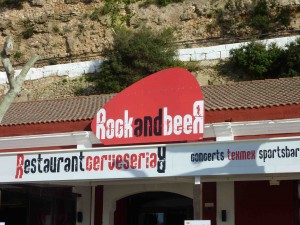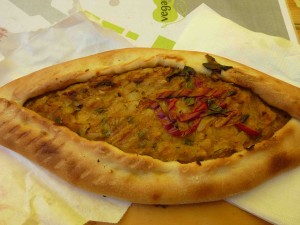Please note: This article was first published on The Vegan Tourist and last updated July 10, 2013. (I deleted inactive/selected links on November 28, 2021.)
I’ve already published several articles about my spring vacation on the island of Menorca, Spain, and here’s another one (more to follow). Not so much a restaurant recommendation, but a true survival tip.
We arrived at Mahon airport in the early afternoon on Sunday, April 21, 2013. The only airline with any kind of useful connecting flights from Vienna to Mahon (via Palma de Mallorca) in April (before the high season starts in May) was Air Berlin, and – just like most (all ?) other airlines – whatever food is served on board is not vegan. By the time we arrived at Apartamentos Royal, I was positively starving.
We set out on foot towards the city centre at about 5:30 PM, in search of a restaurant. The city was deserted. We were literally the only people on the streets. In most Southern European countries, siesta is an essential part of the day: all the shops close, and people go home to eat lunch, take a nap, or do – whatever, really. Point is, they go home, and stay home, and city life shuts down completely. As Spain is predominantly a catholic country, Sunday is a day of rest, and most shops don’t open at all. In addition, the Spanish eat dinner late, at about 8:00 PM.
So there we were, the only people out and about on a Sunday afternoon, starving.
It only took us 15 minutes to reach the city center, where we descended the many steps of Costa de Ses Voltes to reach Baixamar, the harbour district. All the cruise ships dock at the Costa de Ses Voltes, when they reach the port, and all the tourists debark to buy overpriced souvenirs at the bottom of the stairs. The area is quite pretty. But on a Sunday afternoon, shortly before 6:00 PM, it is completely deserted. It’s very strange, really, to stroll through a city – Menorca’s capital, no less – whithout being surrounded by any other people.
At the bottom of the stairs, we turned right (east), and walked along Moll de Llevant, the Eastern Quay, which is lined with shops and restaurants – all closed.

And then we reached Rock & Beer.
It was open. More importantly, the restaurant’s kitchen was also open.
We were saved.
Rock & Beer is not a restaurant I would normally recommend to vegans. It turned out that the only vegan items on the menu were a mixed salad and Pa amb oli (toasted white bread, topped with garlic and olive oil). But Rock & Beer was open on a Sunday, at 6:00 PM, and that’s all that mattered.
I didn’t even care that at Rock & Beer all the tables, which are placed outside the restaurant on the sidewalk, are enclosed on all sides by a plastic “curtain.” The sea is only a few metres away, but there you are, sitting in a plastic bubble. Apparently, this is quite common at restaurants in the Mahon harbour. (As if a little sea breeze ever hurt anyone, especially in the spring or summer. Go figure. ) As Rock & Beer is also a smoking-restaurant – and the smoke can’t escape due to the plastic curtains – you’re exposed to second-hand smoke as well. (As I said, this is not so much a recommendation, but a survival tip.) On the other hand, it’s also a music venue (hence the “rock”).
The Pa amb oli – my first – was a fitting introduction to vegan Menorcan cuisine, even though I didn’t realize it at the time. During the days that followed, I ate a lot of white toasted bread with garlic and olive oil — it would often be the only vegan food on a restaurant’s menu. On that particular Sunday evening, I didn’t care. It was delicious. (Two pieces of Pa amb oli cost 2.50 Euros, incl. tax).
The salad (6.50 Euros, incl. tax) was quite substantial: olives, corn, red onions, carrots, tomatoes, radicchio, and various green salads. It was served without a dressing, but with olive oil & vinegar, and salt & pepper on the side. (This is common in most Southern European countries.)
Starved as I was, I also ordered nachos and guacamole from the starters menu (5.50 Euros, incl. tax). As soon as the waitress brought the dish, I knew I’d made a mistake. The nachos were not plain, but chili nachos. And those – as any vegan will tell you – are almost never vegan (unless they’re organic). At home, I only buy a certain brand of plain organic nachos, which are vegan. Starved and tired as I was, I let down my guard, not considering that even mass-produced non-organic plain nachos aren’t necessarily vegan.
In one of my previous articles – Vegan Survival Tips for Menorca, Spain – I advise you to be specific, when you order your food, and to ask a lot of questions. This is one of the reasons why. At home, I know what to look out for at the restaurants I frequent, but here I was in a different country, unfamiliar with the local cuisine, and not vigilant enough. As a result, I ended up with non-vegan nachos.
If you’re reading this and are not a vegan (or just became a vegan), you might not know that most mass-produced processed snacks (potato chips, nachos, etc.) are not vegan. They often contain sweet whey powder, lactose, natural flavouring (which may be animal-derived), milk protein, and various emulsifiers (many of which are not vegan, either). Consider yourself warned.
Did I eat the nachos? Yes, I did. As a vegan, you’ll occasionally find yourself in similar situations. It just can’t be helped. One simply cannot keep up one’s guard all the time. Each vegan reacts differently in such situations. While I would never eat meat or fish, I have in the past drunk coffe with milk (ordered without, but mistakenly served with milk), eaten egg-fried rice (ordered simply as fried vegetable rice – I wasn’t specific enough, and should have told them that eggs aren’t vegetables), and similar dishes. My attitude is to be as vigilant as I can when ordering food, but when I make a mistake (or the restaurant makes it) – if the damage is done, so to speak – I eat/drink the food. It doesn’t happen often, maybe once or twice a year, but we live in a non-vegan world and it’s almost impossible not to make mistakes on occasion.
So that was Rock & Beer. Good guacamole, a great salad, and toasted bread.
Skip the nachos.
Address: Moll de Llevant 148, 07702 Maó, Menorca
Opening hours: sorry, I failed to check; I was tired after a day of travelling.
Phone: 0034 – 971 – 355 953
Website: They don’t have their own site, but they’re on Facebook



















